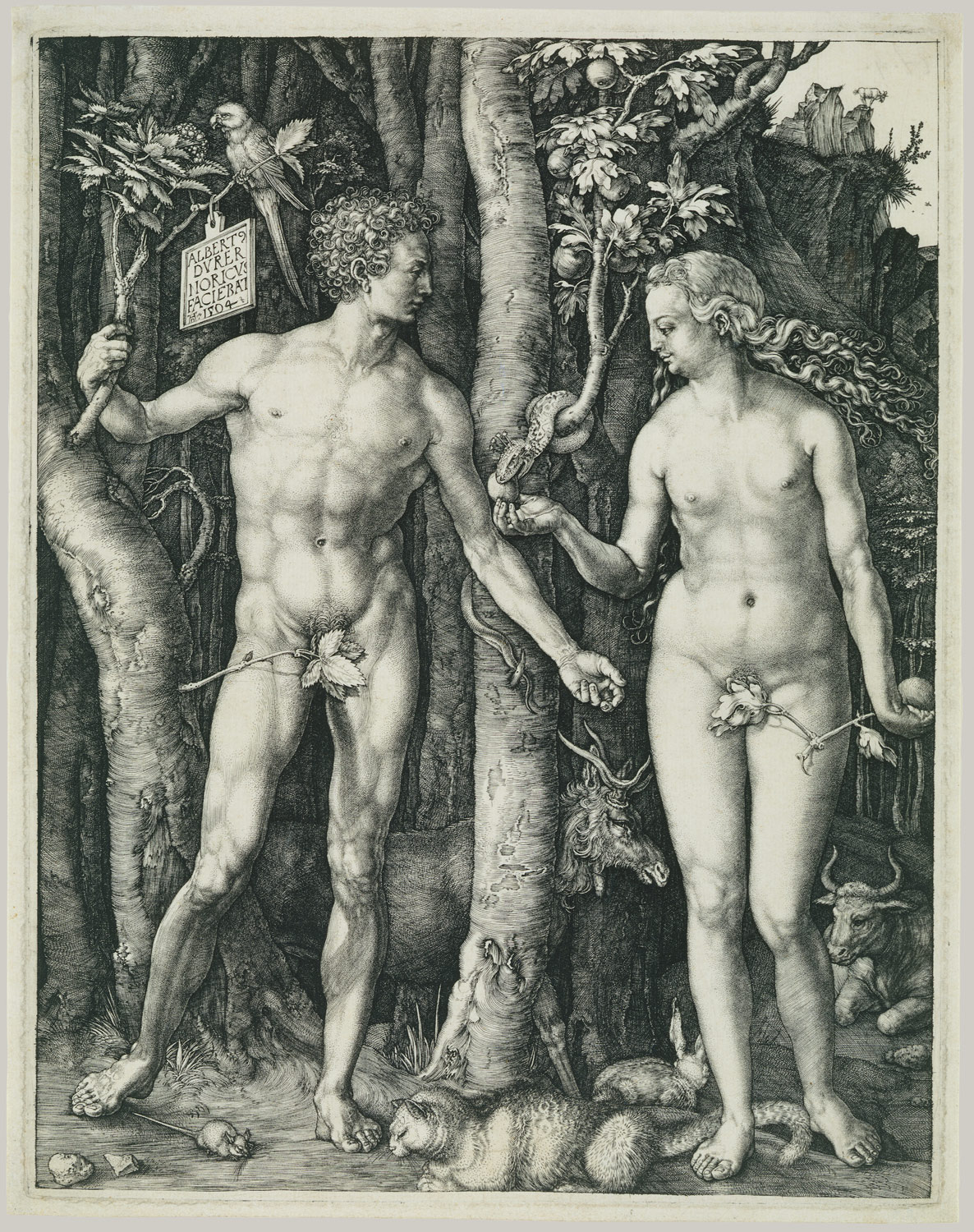December 24
Adam and Eve's Feastday
Christmas Eve
|
Adam and Eve appear in many books besides
Genesis, such as the Quran, the Life of Adam and Eve, the Talmud, and
Gnostic texts. Jewish tradition sometimes includes reference to other
wives of Adam.
Adam and Eve were never officially recognized as saints
by
the early Church. However, they were honored as unofficial saints
throughout the Middle Ages. December 24 was set aside for several
centuries as their feastday and was often celebrated with a
Paradise Play which told the story of humankind
from the creation of Adam and Eve and the Garden of Eden up to the birth
of Messiah in Bethlehem. The play featured a large evergreen tree called
a Paradise Tree, with its branches laden with red apples. Eventually,
small white discs were added representing communion wafers,
the Christian sign of redemption. The apple has traditionally been the most popular symbol of the forbidden fruit mentioned in the Bible, which did not describe the specific fruit of the tree of knowledge of good and evil eaten by Adam and Eve in the Garden of Eden. that Eve ate. "And the Lord God commanded the man, saying, Of every tree of the garden thou mayest freely eat: But of the tree of the knowledge of good and evil, thou shalt not eat of it: for in the day that thou eatest thereof thou shalt surely die." Genesis 1:16-17]. There have been controversies over which fruit the Bible referred to with many scholars believing that the fruit was a pomegranate or a fig. There have also been speculations about the peach, apricot, quince, fig, and banana. There have been a few films portraying the first couple in Paradise, including The Last Eve (2005) with Bruce Khan and Jourdan Lee Khoo as Adam and Kelly Hamilton and Melanie Jean as Eve, Mike Figgis' exquisitely beautiful A Loss of Sexual Innocence (1999) with Femi Ogunbanjo as Adam and Hanne Klintoe as Eve, and John Huston's atrocious The Bible: In the Beginning... (1966) with Michael Parks as Adam and Ulla Bergryd as Eve. |
 |
|
|
Adam and Eve by Albrecht
Curer |
Adam and Eve's Feastday is still celebrated in the Eastern Orthodox Church and often with apple dishes, such as the traditional Adam and Eve pudding.
|
Adam and Eve Pudding |
|
Ingredients |
|
|
1/2 cup sugar
|
1/2 cup raisins
|
| Instructions |
|
|
|
Christmas Eve has traditionally been celebrated with special breads and cakes, a tradition that is rooted in pre-Christian times. With the arrival of the winter solstice, wheat was traditionally offered to the field gods in hopes that the coming spring would produce good planting weather and a good harvest. In Poland and in the Ukraine, sheaves of wheat are brought into the house at Christmas Eve and stacked in the corner of the living roam or ding room The Ukrainians bake their loaves of Kalach which are stacked on each other over a bed of straw, with a candle stuck in the center of the top loaf.
In Germany, Christstollen is the traditional Christmas bread. Stollen is thought to have originated in Dresden in the 1400s. However, at that time the Catholic Church, as part of the fasting rules in preparation for Christmas, forbade the use of butter during Advent. In 1650, Elector Lord Ernst of Saxony and his brother Albrecht appealed to the Pope Urban VIII to rescind the so-called "butter ban" in effect at the time. The Holy Father eventually gave in to their entreaties and declared (in what came to be known as the "Bufferbrief") that milk and butter could indeed be used in baking the stollen - this could be done with a "clear conscience and with God's blessing", after making the "appropriate penance". The restrictions were lifted only in Dresden and thus began a baking tradition that continues to this day.
In Austria, a similar bread called Klentzenbrot is baked.
Norway has its
Julekake, the Czechs, Slovaks, and other middle European countries
have have Kolach, the Greeks have
Christopsomo
, and the Italians
celebrate with
Panettone . Here are two of the recipes.
Christstollen
Ingredients
1/2 cup currants
1 cup candied lemon & orange peel
1 1/2 oz. candied angelica
1/3 cup glacé cherries
1/2 cup rum
1/4 cup warm water
3 packets active dry yeast
2/3 cup sugar
5 1/4 cups flour
1/2 tsp. salt
1/4 tsp. almond extract
1/2 tsp. finely grated lemon rind
2 eggs
3/4 cup (1 1/2 sticks) softened butter, cut small
1/2 cup (1 stick) butter, melted
3/4 cup slivered almonds, blanched
2 Tbsp. powdered sugar
|
Panettone
|
|
Special Equipment |
| An empty 2-pound coffee can
(now marked 23 to 26 ounces) waxed paper |
Ingredients
1/4 cup warm water (110-115° F)
1/2 cup flour
1/2 cup golden raisins
1/4 cup brandy
5 TB. butter, room temperature
2 eggs
4 egg yolks
1/4 cup warm water (110-115° F)
4-1/2 to 5 cups flour
1 tsp anise seed
Grated zest of 1 orange
1/2 cup chopped candied fruit
1/2 cup chopped dried apricots
nonstick cooking spray.